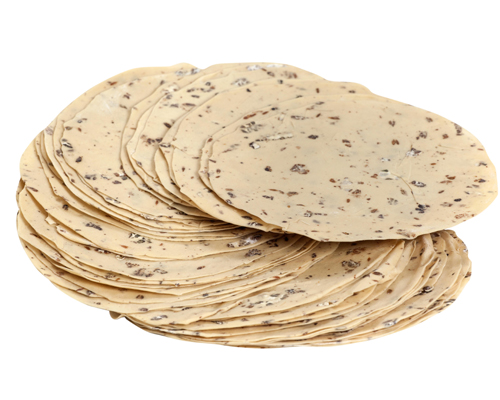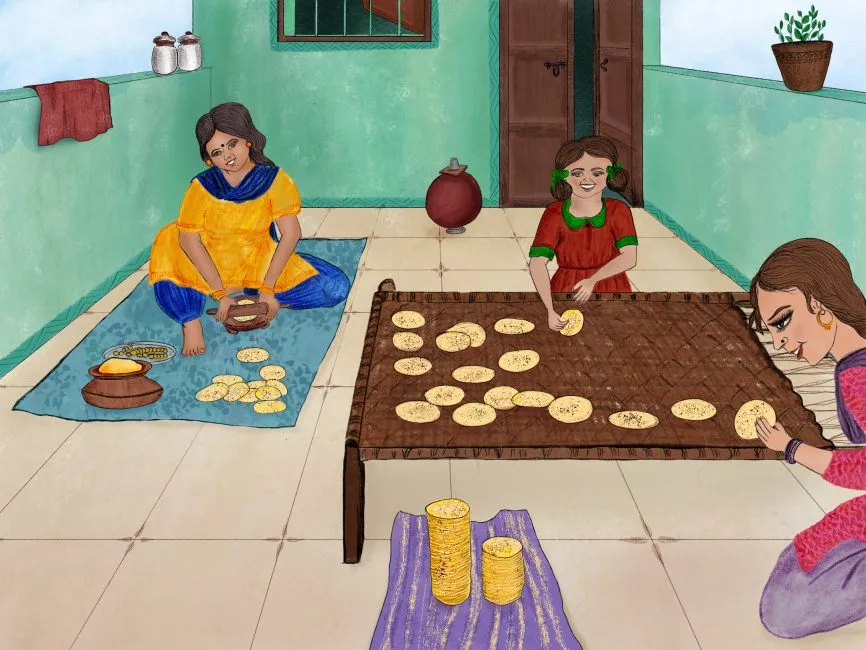
For many Sindhis, food filled in the void of home after Partition. Papad holds a very special place in the galaxy of these dishes.
BY SHRADHA SHAHANI
A few generations ago, if you walked into a Sindhi home and were served water, there’s a chance you’d hear someone remark “tutto pani?” It translates to “[How can you serve] just water?”. No matter what time someone turned up, even if it was unannounced, a glass of water had to be accompanied with papad. It was customary and almost insulting not to do so.
Now, we may not carry it in flights, but papad is to us what theplas are to Gujaratis. Breakfast, lunch, dinner or chai, there really is no ideal time to eat it. We consume so much of it that people from the community are often taunted with jokes; they’re called “Sindhi papad”. The irony is that the same papad that is often made fun of, secured many livelihoods during Partition, when Hindu Sindhis migrated from Sindh to India in search of home. They arrived in the country nearly empty-handed, but for several, the art of making papad came to the rescue.
How to tell it’s Sindhi
Savoury and piquant with hints of dill and pepper—the perfect papad crumbles in your mouth like a wafer, but as you munch, it softens lending it a slightly gummy texture. You know it’s Sindhi when it sticks to your teeth. It fluffs up like a roti when cooked on a flame, sports waves and dents, and tiny little bubbles with occasional specs of black when it’s too charred. “The uniqueness lies in the use of a mix of urad (husked black beans), which lends the crunchiness, and moong dal (green gram), which gives it its chewiness, and dill seeds, coarse black pepper and hing. What also makes it sticky is that it’s not parch dried in the sun. Papads made either from pure urad turn out too flat and cracker-crisp. There are many industry-made papads that use only urad and call their papads Sindhi, but they taste nothing like they’re supposed to. The hand-made ones are also thicker than your standard industry variety,” says Sapna Ajwani, who runs the supper club SindhiGusto in London.

Sindh’s dry scorching heat made for the perfect ground to make papad. Women and children got together in their courtyards, rolling the dough into wafer-thin sheets, and then laid it out to dry. “After Partition, many enterprising women who had suddenly lost all their wealth started making papad and pickles and selling it to better off Sindhis who were sufficiently settled, but not enough to make their own,” says Saaz Aggarwal, author of the book Sindh: Stories from a Vanished Homeland.
“There was nothing like biscuits in Sindh, so every time someone came over, we served papad with water. But it was more than just a snack. My grandfather who was an Ayurveda hakim would tell me that papad—because it is high in salt—would help replenish the sodium lost in your body after perspiring. Since Sindh was very hot, everyone who came over was served papad before a glass of water. It had to be followed by water, so you don’t get a cough from the papad in your throat,” said Dr. Sundri Parchani, who holds a PhD in Sindhi linguistics.
Parchani moved from Sindh to Ajmer when she was a young child. Even after Partition, her family held on to the ritual of making the flatbread at home. “Summers were synonymous with making papad with my grandmother and mother. We made it with simple ingredients that were available to us like split watana dal and channa dal. It tasted so good even when raw that I used to keep munching on it,” she reminisces. A few years later, Parchani moved to Chennai, and the tradition continued, with the help of her South Indian neighbours who loved making and eating a variation to papaddums. “Everything we eat has a lot of oil. Even plain white rice is laced with ghee. My grandfather used to say papad after a meal would act as a blotting paper and absorb the oil. It also enables digestion,” says Parchani.
The making of the Sindhi papad industry
From tiny door-to-door businesses, the papad industry started metamorphosing into a behemoth between the 1980s and 90s. Thousands of Sindhi refugees set up their homes in the military barracks of Ulhasnagar and Kalyan, among other parts of India. The two cities on the outskirts of Mumbai have now become hubs of the multi-million dollar Sindhi papad-making business. The Sindhi diaspora reserves kilos of space in their bags for papad from on their visits to the country.
“Papad is like bread for us. We eat it at all times and with almost anything. We crush it over our khichdi and pair it with spicy chutney. My bag is filled with 5-6kg of it, either bought from Ulhasnagar or a lady who makes them in Jodhpur,” says Ajwani.
Back in Mumbai, Ochiram Passari’s twin shops Shree Vishnu Stores and Shree Shankar Stores in Khar became the closest connection people had to the land they were uprooted from. My 81-year-old grandmother, who also spent her summers making papad when she migrated to India, swears by the store for her supplies.
The late Ochiram Passari owned an Ayurvedic and kirana shop in Shikarpur, Sindh (present-day Pakistan). In 1948, he set up a shop in Chira Bazar in Mumbai’s Girgaum before he moved to Khar. In those days, the store did not sell ready papads, but it had supplies to make them. “Once people started settling down, everyone made it at home. So, we started off by selling the supplies such as the dough mix, papad khar (a type of baking soda used to make papads), hing and jeera,” says Kishore D Maniyal, the grandson of Passari. However, papad-making became just another tradition we lost along the way. “It is a very tedious and time-consuming process. So, more and more people started outsourcing it than making it at home,” says Aggarwal. Passari, too, started selling ready-made papads a few years later. Today, the shop, run by the third and fourth generation, is also famous for its other fried Sindhi delights, including rice kachrees (crisps made of rice flour), phoolpatasha (dried lotus seeds), varis (sundried lentil cake) and kheecha (papade made of rice).
Another famous papad store born from the struggles of Partition is Jaidev Bherumal Parwani’s store Deepak’s – The Sindhi Shop in Bhavani Peth, Pune. His father, too, was an Ayurvedic hakim in Hyderabad, Pakistan who migrated to India and started an essentials store. “There were only a handful of papad manufacturers in the time, and the demand for it kept increasing, with people making less of it at home due to space constraints. My mother used to make the papads we sold initially at Rs5.50/kg (now sold for Rs300/kg). As the business picked up, we trained 16-17 local ladies to make them,” he says. In 1977, the business flourished and Parwani even started exporting papad to different parts of the world, including Canada, the U.S., UK and Singapore. Today, his reach has extended to many more countries. “When I was in school, so many people would tease and call us ‘Sindhi papad’. I used to feel embarrassed about it. But today, I am proud of it.”
Never without my papad
Papad has become more than just our daily bread, in terms of earning and eating. For a community that was uprooted from their land they could never return to, our food has become a way to tightly grip on to what’s left in the absence of a physical place. Even wearing dentures doesn’t stop 90-year-old Singapore resident Arjan Daswani from eating his papad. “I eat it when everyone is sleeping, so no one can scold me,” he laughs. Ajwani shares a similar story of her great-grandmother. “She wanted a papad even in her 90s when she couldn’t bite. My aunt would crush it in and keep it in a dabba, so she could suck on it.”
For London-based businessman Tarun Sakhrani, papad brings back wistful memories of his visits to his grandmother’s home in Mumbai. “The first thing I would do when I visited nanis was raid her steel box with papads. It was never empty because she knew I’d be looking for it. We have mimicked the dabba at home now, and it’s always full,” he says, adding that there’s never a shortage of it in our home. “I have lived in the US, Singapore and London, and yet every time I visit India, I save a few kilos of luggage for my papad.”
For Parchani’s four grandchildren, who live in Toronto and the U.S., the crunchy flatbread tethers them to their ancestor’s land. “They don’t know how to speak Sindhi, but they love their papad,” she laughs. New Jersey-based writer Pooja Makhijani, who has grown up eating Sindhi food, says papad was present in every meal for her. “When I ran out, I would substitute with store-bought tortilla chips to add that extra crunch, but the texture and taste just never matched.”
My father never fails to remind my mother about papad when we sit down for dinner. When it arrives on the table, his share disappears in seconds, and when I look away, so does half of mine. It used to make me furious, but I’ve started to think all is fair when it comes to papad. Our love for it knows no boundaries.
________________
Courtesy: CN Traveller